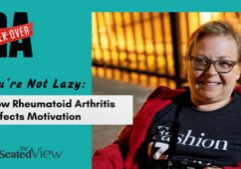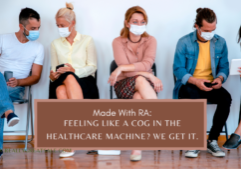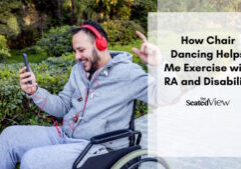Brave New World of Awareness
A few weeks ago, I received an email from Kelly suggesting people in the RA community write blog posts on what rheumatoid awareness means to them, just in time for the February 2 Rheumatoid Awareness Day.

More specifically, she asked “what difference do you think it would make if Rheumatoid Disease were recognized for what it is by everyone…?” And I immediately knew what I wanted to write. Settle in for a bit of speculative creative writing, starring our fictional protagonist, Margo.
Date: In the Future
The next week, Margo makes her way to the Central Rheumatology Clinic to meet her new rheumatologist, a kind, middle-aged man named Dr. Knowsalot. He listens to Margo’s story of her fluctuating symptoms and takes his time examining her. Margo feels safe and in good hands. Despite having only minimal symptoms, Dr. Knowsalot confirms that his assessment of her symptoms and examination, coupled with the results of blood and imaging tests, points to her having RA. He explains that early, aggressive treatment of the disease gives her the best chance for going into remission. Thanks to this type of chronic illness now being treated as a medical emergency, the rates of remission have increased hugely since the old days of the 2010s. Back then, people often had to wait months, sometimes years, and see several different doctors before they got a diagnosis. The doctor explains that scientists are getting close to a cure, but until that happens it’s important to use medication to protect her from the damage RA can cause. Margo is glad to have an explanation for what is going on in her body and feels optimistic that she will feel better soon.
Dr. Knowsalot explains that he wants to protect not just her joints, but also all the other systems in the body that can be affected by the inflammation. Before she leaves his office, several other appointments are made for her. These include a rheumatology social worker, who will help her adjust emotionally to the new diagnosis and connect her to community resources that can be helpful for someone with RA. She also has an appointment with a preventative cardiologist to make sure that her heart is not affected and with an ophthalmologist to double check that her eyes are fine. She’ll also see the pain management specialist in the clinic, because, Dr. Knowsalot says it’s very important to treat her pain to make sure that she has optimal quality of life. He also gives her a card with the phone number to the office and his email address and encourages her to contact him between appointments if she has any questions.
Margo walks out to her car in a daze. One she’s inside, she looks through the cheerful yellow folder she got at the clinic. In it are printouts of her appointments with the other health professionals associated with the clinic, as well as pamphlets covering almost all the questions that were whirling around in her head. She also notices a page of resources, including webpages and blogs in the RA online community, books about living well with RA and many other resources. She already feels part of a community and is surprised that despite just been diagnosed with a chronic illness, she feels certain she can handle it. Must be because there’s so much information and support about her disease, she thinks.
Before she drives home, Margo calls her boyfriend Peter to give him the news. He’s been working with her on research before the appointment and isn’t too surprised at the diagnosis. He’s perfectly supportive and tells her they’ll get through it together. Margo also gives him the contact information for another rheumatology social worker, explaining that Dr. Knowsalot is recommended that her partner also receive some counseling. “Chronic illness can be hard on relationships,” he’d explained, “it’s best to deal with the issues right away so you can work together as a team.”
The next morning at work, Margo pops in to see her boss, Karen, to explain why she’s had to be away for several days. “RA…” Karen says, “isn’t that an autoimmune disease?” Karen doesn’t know too many details, but she is aware that it’s a chronic illness that causes pain and fatigue. Margo isn’t surprised — after all, RA awareness is all over the media every February and everyone knows at least a little about the disease. Karen also offers to set up a meeting with the Accommodation Manager in the company to explore ways in which her employer can help her work more effectively, without unnecessarily draining her. She explains that accommodations are usually quite inexpensive. They often involve simple solutions, such as an ergonomic workstation, a lunchtime lie-down in the Quiet Room that employees use if they are not feeling well or need a breather from a stressful day. She also suggests setting up telecommuting, so Margo can work from home when she needs to conserve her energy.
At the end of the day, Margo sits down to dinner with her boyfriend. He asks her how she feels. “Really hopeful,” she says. “It feels so good to know that I have the support of not just you and my family, but everyone else, as well.”
This post is fiction. But maybe someday soon, it won’t be. Tell the world about RA.
Tag:
6 Comments
Read More
Discover what else I've been writing about...
















I really enjoyed this Lene. I wish for this scenario! Especially in the work situation. Great piece of writing!
Thanks for the story Lene. I read it believing it was real!
Andrew
Brilliant post. Someday this is exactly how it will be, thanks to people like you working to raise awareness.
So funny, as I was reading this I thought… Wha??? Are there people who get this experience?! I do have a super supportive husband, but selfishly felt better to read that this is not the “normal” experience! Thank you for opening my eyes.
I love your vision. I hope one day the rheumatology clinics and hospitals will have an office just to give info about autoimmune arthritis and support after a diagnosis.
Really good post and will be so encouraging for people with a new diagnosis. It could be so easy. With RA at least there's no immediate surgery, no serious chemo. I know all of the problems with RA from experience and if my past had been like your future I bet no one would be able to find any evidence of my RA now